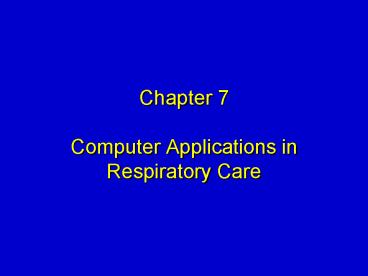Chapter 7 Computer Applications in Respiratory Care - PowerPoint PPT Presentation
1 / 16
Title:
Chapter 7 Computer Applications in Respiratory Care
Description:
Chapter 7 Computer Applications in Respiratory Care Objectives (cont.) Conduct a literature search using the PubMed search engine. Outline steps to maintain security ... – PowerPoint PPT presentation
Number of Views:182
Avg rating:3.0/5.0
Title: Chapter 7 Computer Applications in Respiratory Care
1
Chapter 7 Computer Applications in Respiratory
Care
2
Objectives
- Describe computer systems.
- Describe computer applications in respiratory
care management, clinical care, education, and
research, as well as emerging applications. - Retrieve information from the World Wide Web in
an efficient manner.
3
Objectives (cont.)
- Conduct a literature search using the PubMed
search engine. - Outline steps to maintain security and
confidentiality.
4
Computer Systems
- Consist of desktop, notebook, and handheld
computers that are linked by networks - Servers help manage network functions such as
running software applications. - The Internet consists of government, academic,
and commercial networks. - Internet serves as a conduit for the World Wide
Web and email.
5
Computer Applications
- Word processing Respiratory therapists use
Microsoft Word and Word Perfect to write policy
manuals and monthly reports. - Presentations Students, educators, researchers,
and administrators use PowerPoint to create slide
presentations. - Data processing Microsoft Excel is used to
create spreadsheets in management.
6
Computer Applications (cont.)
- Hospital information systems support both the
administrative and clinical missions of hospitals - Permit virtual chart review of clinical data at
both central and remote locations - Allow clinicians to have access to blood gas
reports, chest radiographs, blood test results,
etc. from all parts of the health care system
7
Computer Applications (cont.)
8
Computer Applications in Respiratory Care
- Respiratory care management information systems
- Charting and billing
- Assign respiratory care orders
- Manage staff productivity
- Report clinical results
- Execute respiratory care protocols
9
Computer Applications in Respiratory Care (cont.)
- Automation of patient-driven protocols
- Pulmonary function laboratories
- Most exercise and metabolic measurement systems
use a desktop or laptop computer. - Computers are used to interpret PFT reports.
- Blood gas laboratories
- Computers are used to store reports and assist
with quality assurance.
10
Emerging Applications
- Electronic health records
- Computers could provide a seamless network of
widely accessible electronic health records. - Tobacco cessation
- Internet-based programs are available.
- Telemedicine
- The use of computers and telecommunications to
provide patient care in remote sites
11
Emerging Applications (cont.)
- Chronic disease management
- Computers can help provide cost-effective care of
patients with chronic pulmonary disease. - Clinical decision support
- Computers can help clinicians better provide
evidence-based care using clinical practice
guidelines.
12
Information Retrieval
- World Wide Web
- Google Scholar a search engine for scholarly
publications - PubMed and MEDLINE
- PubMed is the National Library of Medicines free
search engine for health information. - OVID
- Used by medical libraries and large hospitals as
a search engine
13
Education
- Clinical simulators
- Computerized simulators are powerful learning
aids. - DataARC
- A secured, password-protected, and Web-based data
management system for documenting clinical
educational activities. - Computerized testing for credentialing
14
Research
- Data sources
- Data sources for outcomes research (e.g., birth
and death rates in certain populations) - Data collection
- Handheld computers
- Web-based surveys
- Statistical tests
- SPSS, SAS, Statistica
15
Security and Confidentiality
- Security
- Virus attaches to executable programs and
destroy files and software - Worm similar to a virus but can spread
throughout an entire network - Trojan horse masquerades as a seemingly benign,
legitimate program and invades software - Spyware can be legitimate or malicious software
that controls a computer
16
Security and Confidentiality (cont.)
- Prevention of infiltration by malicious software
- Use of firewalls to filter exchange of
information with the internet - Confidentiality
- Patient data must be kept in password-protected
files. - Access to patient files should be on a
need-to-know basis.































